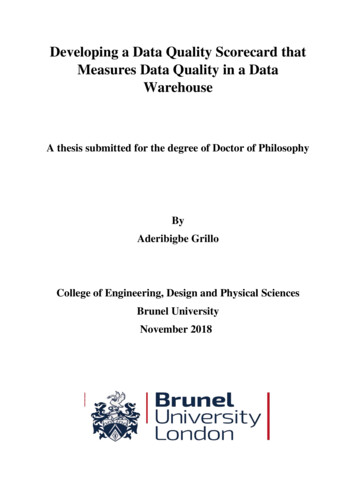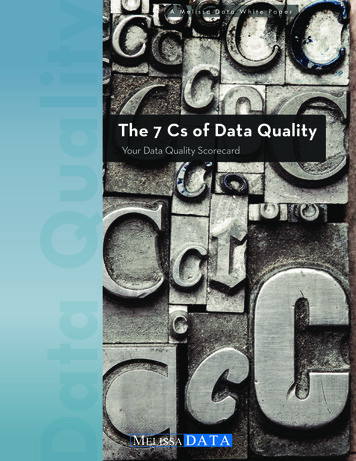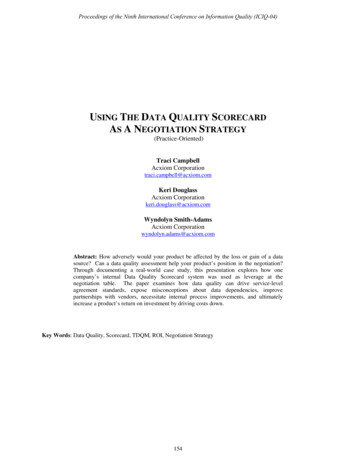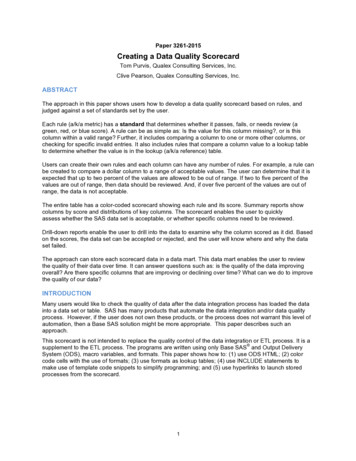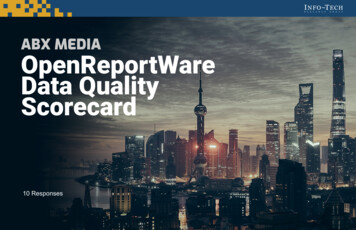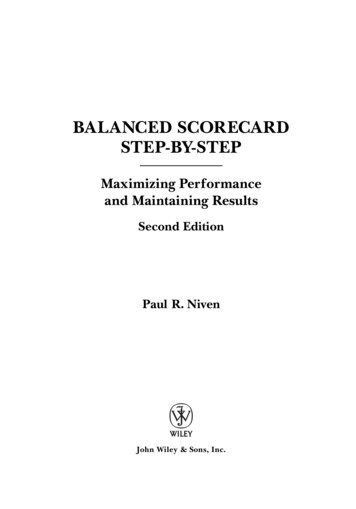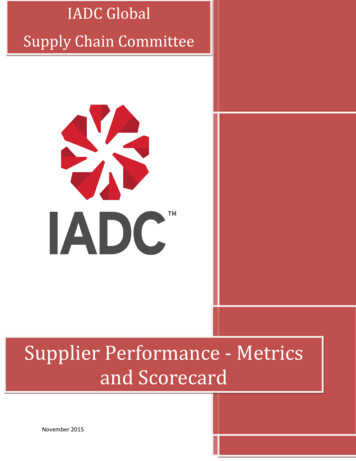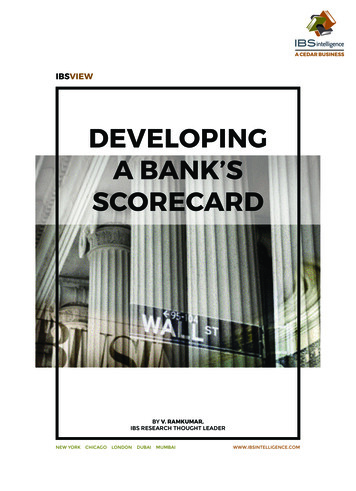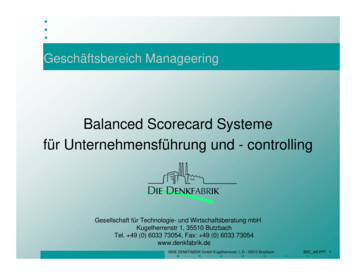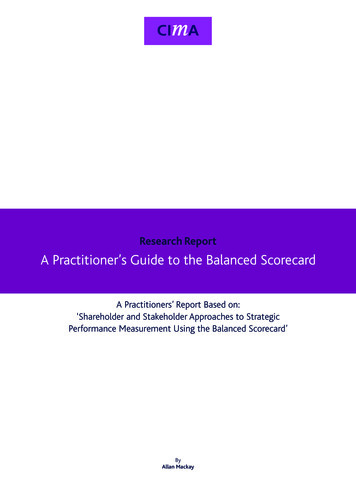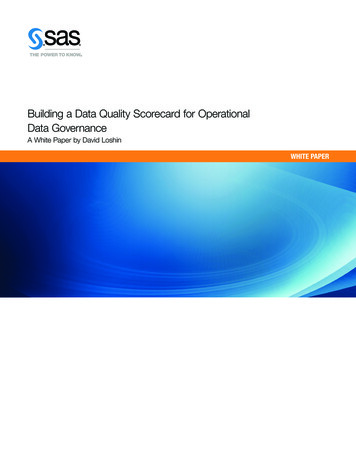
Transcription
Building a Data Quality Scorecard for OperationalData GovernanceA White Paper by David LoshinWHITE PAPER
SAS White PaperTable of ContentsIntroduction. . . . . . . . . . . . . . . . . . . . . . . . . . . . . . . . . . . . . . . . . . . . . . . 1Establishing Business Objectives. . . . . . . . . . . . . . . . . . . . . . . . . . . . . 1Business Drivers . . . . . . . . . . . . . . . . . . . . . . . . . . . . . . . . . . . . . . . . . . 1Success Criteria. . . . . . . . . . . . . . . . . . . . . . . . . . . . . . . . . . . . . . . . . . . 2Data Quality Control and Operational Data Governance . . . . . . . . . . 2Data Quality Inspection and Control . . . . . . . . . . . . . . . . . . . . . . . . . . . 3Data Quality Service Level Agreements . . . . . . . . . . . . . . . . . . . . . . . . 3Monitoring Performance of Data Governance . . . . . . . . . . . . . . . . . . . 4Data Quality Metrics and the Data Quality Scorecard. . . . . . . . . . . . . 4Evaluating Business Impacts and Dimensions of Data Quality. . . . . . . 5Defining Quantifiable Data Quality Metrics . . . . . . . . . . . . . . . . . . . . . . 6Automating the Scorecard Process. . . . . . . . . . . . . . . . . . . . . . . . . . . . 6Capturing Metrics and Their Measurements. . . . . . . . . . . . . . . . . . . . . 7Reporting and Presentation. . . . . . . . . . . . . . . . . . . . . . . . . . . . . . . . . . 8Summary . . . . . . . . . . . . . . . . . . . . . . . . . . . . . . . . . . . . . . . . . . . . . . . . . 9About the Author. . . . . . . . . . . . . . . . . . . . . . . . . . . . . . . . . . . . . . . . . . 10
SAS White PaperIntroductionThere are few businesses today that do not rely on high-quality information to supportperformance and productivity. In today’s organizations, the importance of high-qualitydata is dictated by the needs of the operational and the analytical applications thatwill process the data. Data governance is a means for data quality assurance in twocontexts:1. The ability to protect against negative business impacts by identifying data-qualityissues before any material impact takes place (such as failure to comply withregulations or allowing fraudulent transactions to occur).2. Establishing trust in the data and providing confidence that the organization cantake advantage of business opportunities as they arise.Operational data governance is the manifestation of the processes and protocolsnecessary to ensure that an acceptable level of confidence in the data effectivelysatisfies the organization’s business needs. A data governance program defines theroles, responsibilities and accountabilities associated with managing data quality.Rewarding individuals who are successful at their roles and responsibilities can ensurethe success of the data governance program. To measure this, a data quality scorecardprovides an effective management tool for monitoring organizational performance withrespect to data quality control.Establishing Business ObjectivesIn this paper, we look at taking the concepts of data governance into general practiceas a byproduct of the processes of inspecting and managing data quality control.By considering how the business is affected by poor data quality – and establishingmeasurable metrics that correlate data quality to business goals – organizational dataquality can be quantified and reported within the context of a scorecard that describesthe level of trustworthiness of enterprise data.Business DriversLevels of scrutiny are increasing across the enterprise – industry organizations aredictating expected practices for participation within the community, while municipal,state and federal governments are introducing regulations and policies for both dataquality processes and data quality itself. Successful implementation of automatedbusiness processing streams is related to high-quality data as well. The increased useof business intelligence platforms for measuring performance against operational andstrategic goals is indicative of a maturing view of what the organization’s business driversare, and how performance is supported by all aspects of quality, including data quality.1
SAS White PaperEstablishing the trust of a unified view of business information and decreasing the needfor redundant storage and seemingly never-ending stream of reconciliations helpsimprove operational efficiency. Reviewing the specific ways that information supportsthe achievement of business objectives helps analysts clarify the business drivers fordata governance and data quality and lays out the parameters of what “acceptable dataquality” means within the organization.For example, business clients making decisions using analytic applications dependenton data warehouse data may have to defer making decisions or, even worse, be at riskfor making incorrect decisions when there is no oversight in controlling the quality of thedata in the warehouse. The business user would not be able to provide usable insightinto which customers to target, which products to promote or where to concentrateefforts to maximize the supply chain. In this scenario, a business driver is to ensure anacceptable level of confidence in the reporting and analysis that satisfies the businessneeds defined by the use of enterprise information. Similar drivers can be identifiedin relation to transaction processing, regulatory compliance or conforming to industrystandards.Success CriteriaIdentifying the business drivers establishes the operational governance direction byenabling the data governance team to prioritize the information policies in relationto the risk of material impact. Listing the expectations for acceptable data suggestsquantifiable measurements, and this allows business analysts or data stewards tospecify acceptability thresholds for those emerging metrics. By listing the criticalexpectations, methods for measurement, and specifying thresholds, the business clientscan associate data governance with levels of success in their business activities.For our analytic application example, the success criteria can be noted in relation to theways that data quality improvement reduces time spent on diagnosis and correction.Success will mean increasing the speed of delivering information as well as increasingconfidence in the decisions. Articulating specific achievements or milestones as successcriteria allows managers to gauge individual accountability and reward achievement.Data Quality Control and Operational Data GovernanceA data quality control framework enables the ability to identify and document emergingdata issues, then initiate a workflow to remediate these problems. Operational datagovernance leads to an increase in the level of trust in the data, as the ability to catchan issue is pushed further and further upstream until the point of data acquisition orcreation. A data quality control process provides a safety net that eliminates the needfor downstream users to monitor for poor-quality data. As long as the controls aretransparent and auditable, those downstream users can trust the data that feeds theirapplications.2
SAS White PaperData Quality Inspection and ControlFor years, nobody expected that data flaws could directly affect business operations.However, the reality is that errors – especially those that can be described as violations ofexpectations for completeness, accuracy, timeliness, consistency and other dimensionsof data quality – often impede the successful completion of information processingstreams and, consequently, their dependent business processes. However, no matterhow much effort is expended on data filters or edits, there are always going to be issuesrequiring attention and remediation.Operational data governance combines the ability to identify data errors as early aspossible with the process of initiating the activities necessary to address those errorsto avoid or minimize any downstream impacts. This essentially includes notifying theright individuals to address the issue and determining if the issue can be resolvedappropriately within an agreed time frame. Data inspection processes are instituted tomeasure and monitor compliance with data quality rules, while service level agreements(SLAs) specify the reasonable expectations for response and remediation.Note that data quality inspection differs from data validation. While the data validationprocess reviews and measures conformance of data with a set of defined businessrules, inspection is an ongoing process to:»» Reduce the number of errors to a reasonable and manageable level.»» Enable the identification of data flaws along with a protocol for interactivelymaking adjustments to enable the completion of the processing stream.»» Institute a mitigation or remediation of the root cause within an agreed timeframe.The value of data quality inspection as part of operational data governance is inestablishing trust on behalf of downstream users that any issue likely to cause asignificant business impact is caught early enough to avoid any significant impact onoperations. Without this inspection process, poor-quality data pervades every system,complicating practically any operational or analytical process.Data Quality Service Level AgreementsA key component of governing data quality control is an SLA. For each processingstream, we can define a data quality SLA incorporating a number of items:»» Location in the processing stream that is covered by the SLA.»» Data elements covered by the agreement.»» Business effects associated with data flaws.»» Data quality dimensions associated with each data element.»» Expectations for quality for each data element for each of the identifieddimensions.»» Methods for measuring against those expectations.3
SAS White Paper»» Acceptability threshold for each measurement.»» The individual to be notified in case the acceptability threshold is not met.»» Times for expected resolution or remediation of the issue.»» Escalation strategy when the resolution times are not met.Monitoring Performance of Data GovernanceWhile there are practices in place for measuring and monitoring certain aspects oforganizational data quality, there is an opportunity to evaluate the relationship betweenthe business impacts of noncompliant data as indicated by the business clients and thedefined thresholds for data quality acceptability. The degree of acceptability becomesthe standard against which the data is measured, with operational data governanceinstituted within the context of measuring performance in relation to the data governanceprocedures.This measurement essentially covers conformance to the defined standards, as wellas monitoring the staff’s ability to take specific actions when the data sets do notconform. Given the set of data quality rules, methods for measuring conformance, theacceptability thresholds defined by the business clients, and the SLAs, we can monitordata governance. And we can observe not only compliance of the data to the businessrules, but also the compliance of data stewards to observing the processes associatedwith data risks and failures.Data Quality Metrics and the Data Quality ScorecardPutting the processes in place for defining a data quality SLA for operational datagovernance depends on measuring conformance to business expectations andknowing when the appropriate data stewards need to be notified to remediate an issue.This requires two things: a method for quantifying conformance and the threshold foracceptability.Since business policies drive the way the organization does business, business policyconformance is related to information policy conformance. Data governance reflectsthe way that information policies support the business policies and impose data rulesthat can be monitored throughout the business processing streams. In essence,performance objectives center on maximizing productivity and goodwill while reducingorganizational risks and operating costs. In that context, business policies are defined orimposed to constrain or manage the way that business is performed, and each businesspolicy may loosely imply (or even explicitly define) data definitions, information policies,and even data structures and formats.4
SAS White PaperTherefore, reverse engineering the relationship between business impacts and theassociated data rules provides the means for quantifying conformance to expectations.These data quality metrics will roll up into a data quality scorecard. This suggests that agood way to start establishing relevant data quality metrics is to evaluate how data flawsaffect the ability of application clients to efficiently achieve their business goals. In otherwords, evaluate the business impacts of data flaws and determine the dimensions ofdata quality that can be used to define data quality metrics.Evaluating Business Impacts and Dimensions of Data QualityIn the context of data governance, we seek ways to effectively measure conformanceto the business expectations that are manifested as business rules. Categorizing theimpacts associated with poor data quality can help to simplify the process of evaluation– distinguishing monetary impacts (such as increased operating costs or decreasedrevenues) from risk impacts (such as those associated with regulatory compliance orsunk development costs) or productivity impacts (such as decreased throughput).Correlating defined business rules, based on fundamental data quality principles,allows one to represent different measurable aspects of data quality, and can beused in characterizing relevance across a set of application domains to support thedata governance program. Measurements can be observed to inspect data qualityperformance at different levels of the operational business hierarchy, enabling monitoringof both line-of-business and enterprise data governance.At the data element and data value level, intrinsic data quality dimensions focus on rulesrelating directly to the data values themselves out of a specific data or model context.Some examples of intrinsic dimensions are:»» Accuracy – the degree with which data values agree with an identified source ofcorrect information.»» Lineage – documentation of the ability to identify the originating source of anynew or updated data element.»» Structural consistency – characterizing the consistency in the representationof similar attribute values, both within the same data set and across the datamodels associated with related tables.Contextual dimensions depend on the ways that business policies are imposed overthe systems and processes relating to data instances and data sets. Some samplecontextual dimensions are:»» Timeliness – the time expectation for accessibility of information.»» Currency – which information is current with the world that it models.»» Consistency – relationships between values within a single record, or acrossmany records in one or more tables.»» Completeness – the expectation that certain attributes are expected to haveassigned values in a data set.5
SAS White PaperDefining Quantifiable Data Quality MetricsHaving identified the dimensions of data quality that are relevant to the businessprocesses, we can map the information policies and their corresponding businessrules to those dimensions. For example, consider a business policy that specifies thatpersonal data collected over the Web may be shared only if the user has not optedout of that sharing process. This business policy defines information policies; the datamodel must have a data attribute specifying whether a user has opted out of informationsharing, and that attribute must be checked before any records may be shared. Thisalso provides us with a measurable metric: the count of shared records for those userswho have opted out of sharing.The same successive refinement can be applied to almost every business policy andits corresponding information policies. As we distill out the information requirements,we also capture assertions about the business user expectations for the result ofthe operational processes. Many of these assertions can be expressed as rules fordetermining whether a record does or does not conform to the expectations. Theassertion is a quantifiable measurement when it results in a count of nonconformingrecords, and therefore monitoring data against that assertion provides the necessarydata control.Once we have reviewed methods for inspecting and measuring against thosedimensions in a quantifiable manner, the next step is to interview the business usersto determine the acceptability thresholds. Scoring below the acceptability thresholdindicates that the data does not meet business expectations, and highlights theboundary at which noncompliance with expectations may lead to material impact tothe downstream business functions. Integrating these thresholds with the methods formeasurement completes the construction of the data quality control. Missing the desiredthreshold will trigger a data quality event, notifying the data steward and possibly evenrecommending specific actions for mitigating the discovered issue.Automating the Scorecard ProcessArticulating data quality metrics is a valuable exercise, and in fact may supplementmetrics or controls that already are in place in some processing streams. However,despite the existence of these controls for measuring and reporting data validity,frequently there is no framework for automatically measuring, logging, collecting,communicating and presenting the results to those entrusted with data stewardship.Moreover, the objective of data governance is not only to report on the acceptability ofdata, but also to remediate issues and eliminate their root causes with the reasonabletimes established within the data quality SLA.6
SAS White PaperIdentifying the metrics is good, but better yet is integrating their measurements andreporting into a process that automatically inspects conformance to data expectations(at any point where data is shared between activities within a processing stream),compares the data against the acceptability thresholds, and initiates events to alertdata stewards to take specific actions. It’s these processes that truly make governanceoperational.Capturing Metrics and Their MeasurementsThe techniques that exist within the organization for collecting, presenting and validatingmetrics must be evaluated in preparation for automating selected repeatable processes.Cataloging existing measurements and qualifying their relevance helps to filter outprocesses that do not provide business value and reduces potential duplication ofeffort in measuring and monitoring critical data quality metrics. Surviving measurementsof relevant metrics are to be collected and presented in a hierarchical mannerwithin a scorecard, reflecting the ways that individual metrics roll up into higher levelcharacterizations of compliance with expectations while allowing for drill-down to isolatethe source of specific issues. As is shown in Figure 1, collecting the measurements for adata quality scorecard would incorporate:1. Standardizing business processes for automatically populating selected metricsinto a common repository.2. Collecting requirements for an appropriate level of design for a data model forcapturing data quality metrics.3. Standardizing a reporting template for reporting and presenting data qualitymetrics.4. Automating the extraction of metric data from the repository.5. Automating the population of the reporting and presentation template.7
SAS White Pape
Data Quality Metrics and the Data Quality Scorecard Putting the processes in place for defining a data quality SLA for operational data governance depends on measuring conformance to business expectations and knowing when the appropriate
